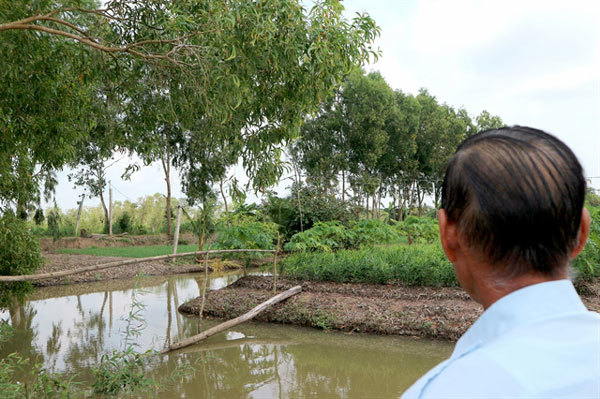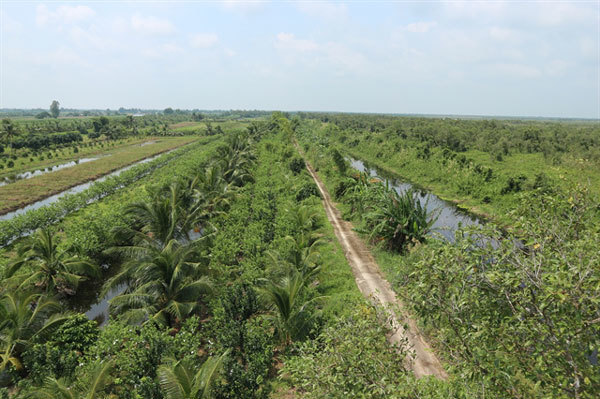Kien Giang focuses on eco-tourism in U Minh Thuong National Park
Kien Giang’s U Minh Thuong seeks to revive freshwater fish populations
 |
| Rows of gingers are expected to bring Sau Tuan great profit by the end of the year. — VNS Photo Khoa Thu |
In mid-September, the ginger is growing well.
“If the weather stays fair, by the end of the year, I will earn at least VND400 million (US$17,200),” he said.
Seven years ago, the farmer, who lives in the buffer zone of U Minh Thuong National Park, couldn't have dreamed of making such an amount.
Tuan’s four-hectare garden is home to lots of other products such as sweet potato, taro, coconut and green onion.
“My children were about to go to Binh Duong Province. Now, instead of spending monotonous days in dusty factories, they can help take care of the garden. The profit is also much bigger,” he added.
Recalling his struggles with poverty, Tuan said his life started changing thanks to a $750 grant and policy changes that helped 53 households in the area.
Profit-sharing
U Minh Thuong, literally translated as Upper U Minh, in the southwestern province of Kien Giang, is part of U Minh – the most extensive peat swamp area and richest place of plant and animal biodiversity in the Mekong River basin.
Despite being near the sea, U Minh Thuong has a freshwater wetland ecosystem. The area receives the most rainfall in Mekong Delta, from 2,600 to 2,700mm, mostly in the wet season from May to November.
The peat acts like a sponge which absorbs rainwater during wet seasons then gradually drains it during dry seasons.
The waterlogged conditions help protect the swamp from forest fires, push back seawater and regulate water levels to minimise the risk of flooding and drought.
Previously, people living in the buffer zone had open access to the water reserve in U Minh Thuong which they used along with rainwater to grow vegetables.
Only two months after U Minh Thuong National Park was established a catastrophic blaze in March and April, 2002 destroyed more than 3,200ha of melaleuca cajuputi – the dominant tree species in the peat swamp forest. A dyke system covering U Minh Thuong National Park’s core zone was then built to store water, helping peat accumulate, grow melaleuca and prevent fires.
The dyke cut off the community's access to fresh water for daily life and farming during dry seasons.
Farmers like Sau Tuan, who had been handed 4ha of forest land in 1994, didn't know what to do with their livelihoods under threat.
As he doesn't own forest land, he can't sell or rent it out.
“We could not cultivate rice here as rats and birds destroyed all the plants,” he said.
Borrowing money from loan sharks to grow vegetables was the only solution, which pushed them into a vicious cycle of poverty.
Struggling to make ends meet, many local residents trespassed into the national park to hunt, threatening wildlife and creating risks of forest fires.
In response to the situation, in 2007, the national park’s management board, local authorities and residents of the buffer zone came to an agreement on water resource sharing.
According to the document, the board has to open dyke to drain water from the peatland to local farms at the end of dry seasons or in case of drought.
Kien Giang Province’s authorities also invested in two pumping systems for U Minh Thuong National Park, aiming to protect the forest and supply water for agricultural development.
As water was released, so were fish living in the wetland. Farmers set up nets at dyke gates to catch fish and raise them in their ponds which brings them another source of income.
In 2010, a group of 53 households living in the buffer zone was established, with Sau Tuan’s family a member.
Each of them received a $750 grant in 2012 from U Minh Thuong National Park management board.
The families had to come up with farming plans based on their expertise and financial capacity to get the money.
The local agricultural agency and animal health agencies helped them with technical problems.
The buffer zone’s area of melaleuca was reduced, saving land for developing agriculture.
For their part, households committed to protecting the reserve from trespassing and illegal hunting.
“Since the disastrous flames 17 years ago, no blaze has hit the forest," said Le Phat Quoi, a soil scientist from Viet Nam National University in HCM City.
"Thanks to this flexible approach, lives of local households have seen an improvement, meanwhile, the peatland’s ecosystem has time to recover,” he added.
Wetland protection and better livelihood for people in the buffer area should be two parallel processes, Quoi said.
U Minh Thuong National Park has had notable success in getting the community involved in caring for the forest.
In 2016, another commitment was reached among the national park’s management board and U Minh District’s Minh Thuan and Minh Bac communes in which VND40 million ($1,720) would be allocated every year till 2020 to develop infrastructure and agriculture. At the same time, local communities agreed to plant trees and protect the forest.
Tram Chim National Park in Dong Thap Province, for example, which has a higher population and local authorities do little to support the buffer zone community, is more vulnerable to forest fires. Last year, an inferno in April destroyed 2,700sq.m of the park’s grass.
U Minh Thuong National Park has also become a role model for other peatlands in Southeast Asia.
“I felt such huge pride when I was invited to Thailand to share my experiences. A group of experts from Malaysia once came here to see our success with a hope to adapt it in their communities,” said Sau Tuan.
U Minh Thuong is the only nature reserve in Vietnam recognised as ASEAN Heritage Park and Ramsar site.
 |
Water management
According to Tran Van Thang, deputy director of U Minh Thuong National Park, water management in the peatland serves three main goals, namely preventing forest fires, protecting peat and ensuring the development of trees.
Since the dyke system was constructed, too much water being stored has led to the formation of permanent water bodies in some parts of U Minh Thuong.
Peat layers have become flimsy while the growth of the melaleuca forest has been restrained. The changes in ecosystem have affected the reserve’s biodiversity, especially when wet seasons come late and extreme weather events happen more often, posing challenges to water management in U Minh Thuong National Park.
“It is not only people living in the buffer zone relying on the water source from the peat swamp to cultivate, but we also need to monitor and adjust water levels inside the reserve to maintain its biodiversity,” said Thang.
“Therefore, it is essential to have proper discussions with local communities whenever we need to discharge stocked water for them to adjust their cultivation plans,” he added.
However, to nurture and promote the biodiversity of U Minh Thuong National Park, enhancing the participation of local communities is just the first step.
“U Minh Thuong has set a good example for protection with civil engagement yet conservation is another story,” said Nguyen Duc Tu, IUCN (International Union for Conservation of Nature) Viet Nam Water and Wetland Coordinator.
“Of course, the change cannot be realised overnight but we have reasons to believe in further improvements,” he added. VNS
Khoa Thu
 Chopping open a coconut, pouring the liquid into a cup and taking a big slurp, Nguyen Quoc Tuan, also known as Sau Tuan, carefully observes his four rows of ginger." itemprop="description" />
Chopping open a coconut, pouring the liquid into a cup and taking a big slurp, Nguyen Quoc Tuan, also known as Sau Tuan, carefully observes his four rows of ginger." itemprop="description" />